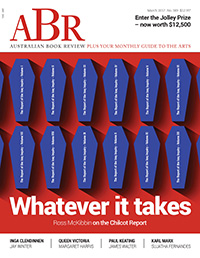Margaret Harris
Margaret Harris reviews 'Outlaw and Lawmaker' by Rosa Praed and 'Mothers of the Novel' by Dale Spender
I first met Rosa Praed under the blue dome of the British Museum Reading Room some twenty years ago. She was introduced as Mrs Campbell Praed, an aspiring novelist advised by George Meredith – himself a novelist and poet, and the subject of my doctoral research – in his capacity as publisher’s reader for the well-known house of Chapman & Hall. The fact of her being an Australian writer seeking to break into the London publishing scene in the 1880s was notable; but she was marginal to my concerns at that time.
... (read more)Chilcot and Australia
Dear Editor,
We cannot be reminded often enough of the perfidy that led in succession to the Iraq disaster, the continuing débâcle in the Middle Eas ...
Margaret Harris reviews 'Victoria: The woman who made the modern world' by Julia Baird
The Empire over which Queen Victoria ruled for more than sixty years no longer paints the globe red. Yet Victoria is still ubiquitous. She is memorialised in the Commonwealth of Australia – formally proclaimed just three weeks before she died on 22 January 1901 – in the names of two states and innumerable other places, along with material objects like statues an ...
Maraget Harris reviews 'Victorian Bloomsbury' by Rosemary Ashton
‘Victorian Bloomsbury’ appears to be a contradiction in terms. ‘Bloomsbury’, as in ‘the Bloomsbury Group’, is shorthand for the group of writers, artists, and thinkers including Virginia and Leonard Woolf, Clive and Vanessa Bell, Duncan Grant, and Maynard Keynes, who gathered in the area of central London between Euston Road and Holborn in the early decades of the twentieth century. Disparate in some ways, they united in reaction against what they felt to be the oppressive social conventions and outmoded values of the Victorian period, a reaction epitomised by Lytton Strachey’s irreverent Eminent Victorians (1918).
... (read more)Margaret Harris and Fiona Morrison on 'The Man Who Loved Children' and 'Letty Fox' by Christina Stead
Christina Stead is an author perennially ripe for rediscovery. Her acknowledged masterpiece, The Man Who Loved Children, came out originally in 1940; in 2005, it figured in Time’s list of the 100 best novels published since 1923. But in his introduction to the Miegunyah Modern Library edition of the novel, American novelist Jonathan Franzen cites ...
It’s not often that literature makes the front page of the Sydney Morning Herald, but on 3 November 2006 the lead story was a report by David Marr about the National Library of Australia’s purchase of a collection of Patrick White’s papers, previously thought destroyed. Other media, both in Australia and internationally, picked up the story. The T ...
Anne Pender reviews 'Dearest Munx: The Letters of Christina Stead and William J. Blake' by Margaret Harris
This edition of Christina Stead’s letters to her lifelong partner, William J. Blake, offers an intriguing window into a passionate literary marriage. It also provides a welcome addition to Stead studies. Readers do not often have access to the personal letters of a great writer, let alone access to such a rich correspondence between a writer and his or her partner. As Stead’s partner was also a writer, this correspondence is peculiarly and delightfully literary.
... (read more)John Hanrahan reviews 'A.D. Hope' by Kevin Hart, 'James McAuley' by Lyn McCredden, 'Peter Porter' by Peter Steele, 'Reconnoitres' edited by Margaret Harris & Elizabeth Webby, 'Annals of Australian Literature' edited by Joy Hooton & Harry Heseltine
Oxford University Press has begun a welcome series called Australian Writers. Two further titles, Imre Salusinszky on Gerald Murnane and Ivor Indyk on David Malouf, will appear in March 1993, and eleven more books are in preparation. Though I find the first three uneven in quality, they make a very promising start to a series. In some ways they resemble Oliver and Boyd’s excellent series, Writers and Critics, even being of about the same length. However this new series is less elementary, more demanding of the reader. It is, predictably, far sparser in critical evaluation, concentrating on hermeneutics, and biographical information is as rare as a wombat waltz.
... (read more)




